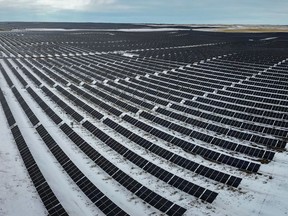Wind turbines prohibited in some regions to preserve views, while solar projects will need to prove compatibility if built on top-tier agricultural land

EDMONTON — The Alberta government has confirmed new rules for wind and solar energy projects it says are needed to protect the environment, food security and the province’s scenery.
Among the new regulations is a prohibition on wind projects within a specified 70,000-square-kilometre “buffer zone” that surrounds the Rocky Mountains and reaches to the western half of Calgary, according to a map published by the government Friday.
Renewable energy projects also won’t be allowed on top-grade agricultural land unless developers can prove the projects can productively coexist with livestock and crops.
Renewable, and non-renewable, electricity projects located in other select areas — including around Cypress Hills provincial park and large pockets of southern Alberta — will need to be assessed for their effect on landscape views before possible approval.
According to the government’s map, more than 82,000 square kilometres of the province is covered under this visual impact consideration.
The new regulations state projects in these areas will require “visual impact assessments,” wherein project proponents will have to demonstrate to the Alberta Utilities Commission, the provincial utilities regulator, what effect the proposed development will have on the surrounding area.
The regulations state that these assessments must include “visual simulations from key vantage points” as well as potential mitigation measures that could be taken.
Also set out in regulation now is a requirement for renewable energy developers to pony up ahead of time all reclamation costs through a mandatory security or bond either to the province or to private landowners.
“By conserving our environment, agricultural lands and beautiful viewscapes, our government is protecting and balancing Alberta’s long-term economic prosperity,” said Utilities Minister Nathan Neudorf in a news release Friday.
“Our government will not apologize for putting Albertans ahead of corporate interests.”
The zone requirements take effect immediately, while the reclamation security requirement comes into effect Jan. 1.
Jason Wang, senior electricity analyst with the Pembina Institute clean energy think tank, says he’s glad the regulations have been finalized but he thinks the new rules still leave unanswered questions.
“It’s not clear exactly how those impact assessments will be used or assessed,” he said. “So for developers it’s still wrapped in uncertainty over exactly how you should be developing a project.”
Wang also said the new regulations go further than what the Pembina Institute was expecting in a couple of instances, namely a provision that classifies parts of land in 13 rural municipalities as off-limits, regardless of whether or not that land falls within a visual impact area or is considered prime crop land.

Additional clarity on renewables policy welcomed
Kara Westerlund, the president of Rural Municipalities of Alberta, said in a government news release that her organization is “optimistic” the new rules will be beneficial for everybody involved.
“These requirements will support industry accountability and positive relationships between renewable companies, municipalities and landowners,” she said.
The director of Business Renewables Centre-Canada, Jorden Dye, says he thinks the new regulations are more of a procedural change than a policy change, as the provincial utilities regulator has been following the government’s policy direction since February.
“I think where we’ve got clarity is on where (visual assessments) will be required,” said Dye, whose organization works to connect renewable energy suppliers with buyers.
“That was an issue coming out of the moratorium — developers couldn’t tell if their project was going to be impacted or not — so that is good we have clarity on that now.”
Dye also said he’ll be waiting to see how the utilities regulator interprets the new rules around Alberta’s scenic mountain areas and the visual impacts that renewable energy projects will have.
“It’s actually going to be once we start seeing (regulator) hearings going forward and how they’re applying a standard, what projects are approved or not, before we start understanding how this will be impacting the industry fully,” he said.
“Oil and gas wells use 125 times as much land as renewable energy in the province and not all of that’s on agricultural land, but a lot of it is,” Wang said.
“We should be dealing with our public policy problems head-on directly, not isolating one sector that just has such a small impact.”